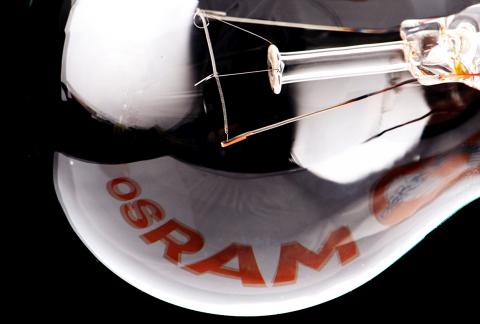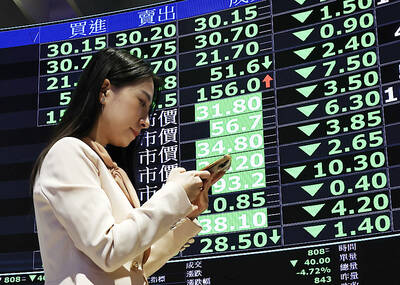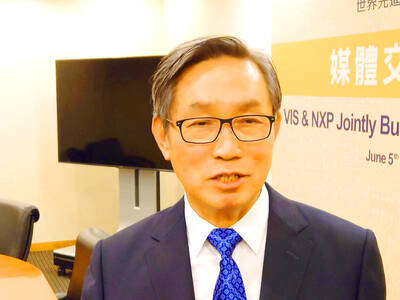Siemens AG announced plans to eliminate an additional 4,700 jobs at its Osram lighting unit after it injected 699 million euros (US$908 million) in capital to the subsidiary it is preparing to spin off next year.
The job cuts, primarily outside Germany, come on top of 1,900 positions that Osram already reduced in fiscal year 2012 and will help reap 1 billion euros (US$1.3 billion) in cost savings as the market for traditional light bulbs shrinks, the company said on Friday in a statement.
In total, the job losses at Osram will amount to about 7,300 positions. The measures will cost a “mid-three digit million figure” through 2014, with the savings realized in full a year later.

Photo: AFP
Siemens said this week that it would spin off Osram next year and retain about a fifth of the company, after realizing that investments to keep pace in the lighting market would be too great for the engineering company to shoulder. Siemens trails Royal Philips Electronics NV in the market for lighting, which is tilting toward LED technology based on semiconductors.
“Personnel increases in the future fields will only partially compensate for the change in the traditional businesses,” Osram chief executive officer Wolfgang Dehen said in the release. Osram had about 39,000 employees as of Sept. 30.
The majority of roles will be lost by selling factories abroad, mainly smaller plants or facilities making products that have reached the end of their life cycle, Osram said.
In Germany, three sites will be affected, including in Berlin and Munich, where Siemens is based. Of the planned savings of 1 billion euros, about 25 percent will be staff related, while the majority will come from lower purchasing costs and productivity gains, Osram spokesman Constantin Birnstiel said.
Siemens estimates the total lighting market will grow by about 5 percent each year to 2016, with LED market volume to quadruple by then to 37 billion euros, according to figures compiled by McKinsey & Co. The market for traditional lighting products will fall by 15 percent in that time, the data show.
Both Siemens and Philips have sought to push into the LED market, with Siemens opening a plant in China that will eventually employ 1,700 people.
Philips, based in Amsterdam, has also deepened job cuts at lighting facilities, and the company announced reductions at a factory in Belgium this month.

TARIFFS: The global ‘panic atmosphere remains strong,’ and foreign investors have continued to sell their holdings since the start of the year, the Ministry of Finance said The government yesterday authorized the activation of its NT$500 billion (US$15.15 billion) National Stabilization Fund (NSF) to prop up the local stock market after two days of sharp falls in reaction to US President Donald Trump’s new import tariffs. The Ministry of Finance said in a statement after the market close that the steering committee of the fund had been given the go-ahead to intervene in the market to bolster Taiwanese shares in a time of crisis. The fund has been authorized to use its assets “to carry out market stabilization tasks as appropriate to maintain the stability of Taiwan’s

STEEP DECLINE: Yesterday’s drop was the third-steepest in its history, the steepest being Monday’s drop in the wake of the tariff announcement on Wednesday last week Taiwanese stocks continued their heavy sell-off yesterday, as concerns over US tariffs and unwinding of leveraged bets weighed on the market. The benchmark TAIEX plunged 1,068.19 points, or 5.79 percent, to 17,391.76, notching the biggest drop among Asian peers as it hit a 15-month low. The decline came even after the government on late Tuesday authorized the NT$500 billion (US$15.2 billion) National Stabilization Fund (國安基金) to step in to buoy the market amid investors’ worries over tariffs imposed by US President Donald Trump. Yesterday’s decline was the third-steepest in its history, trailing only the declines of 2,065.87 points on Monday and

TARIFF CONCERNS: The chipmaker cited global uncertainty from US tariffs and a weakening economic outlook, but said its Singapore expansion remains on track Vanguard International Semiconductor Corp (世界先進), a foundry service provider specializing in producing power management and display driver chips, yesterday withdrew its full-year revenue projection of moderate growth for this year, as escalating US tariff tensions raised uncertainty and concern about a potential economic recession. The Hsinchu-based chipmaker in February said revenues this year would grow mildly from last year based on improving supply chain inventory levels and market demand. At the time, it also anticipated gradual quarter revenue growth. However, the US’ sweeping tariff policy has upended the industry’s supply chains and weakened economic prospects for the world economy, it said. “Now

An employment discrimination lawsuit against contract chipmaker Taiwan Semiconductor Manufacturing Co (TSMC, 台積電) might soon be expanded after a hearing in a federal court in San Jose, California, on Tuesday to add 15 plaintiffs to the case. According to a court document, the lawsuit, which was refiled in November last year as a form of a class action with 13 plaintiffs in California, wants to add 15 plaintiffs from Arizona, where TSMC is building up its wafer fab capacity. TSMC first committed between 2020 and last year to invest US$65 billion in three advanced wafer fabs in Arizona. It then pledged an